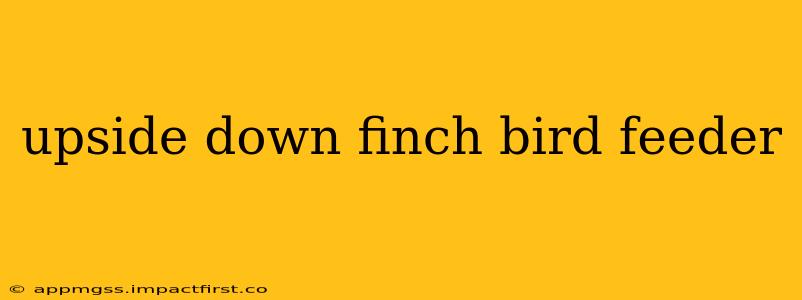Upside-down finch feeders have revolutionized backyard bird feeding, offering a unique and effective way to attract these charming little birds. Their innovative design, often featuring multiple feeding ports and a protective cage, keeps larger birds away while providing a convenient and mess-free feeding experience for finches. This guide delves into everything you need to know about these specialized feeders, addressing common questions and concerns.
What Makes an Upside-Down Finch Feeder Unique?
The key feature, as the name suggests, is its inverted design. Instead of a platform or tray, the seed is held within a cage, suspended above the feeding ports. This forces finches to hang upside down to access the seeds, effectively excluding larger birds like squirrels, doves, and jays who lack the necessary agility and balance. This clever design minimizes seed waste and keeps the feeding area cleaner. Many models also include a weather-resistant design to protect the seeds from rain and snow.
How Do Upside-Down Finch Feeders Work?
The mechanics are simple but ingenious. The feeder typically consists of a reservoir holding the seed, a protective mesh or cage surrounding the seed, and several small feeding ports through which the finches access the seeds. When a finch lands, it clings to the mesh, hangs upside down, and pecks at the seeds through the openings. The design prevents larger birds from easily reaching the seed, resulting in a more efficient and enjoyable feeding experience for finches. Some models feature suction cups for easy attachment to windows, offering an excellent viewing opportunity.
What Types of Seeds Are Best for Upside-Down Finch Feeders?
Finches are attracted to a variety of small seeds. Nyjer (thistle) seed is a popular choice, as finches love it and larger birds tend to avoid it. Sunflower chips and white proso millet are also good options. Avoid using cracked corn or larger seeds, as these can be accessed and wasted by larger birds. Always check the seed regularly to ensure freshness and to avoid spoiling.
Are Upside-Down Feeders Better Than Traditional Feeders?
Upside-down feeders offer several advantages over traditional feeders. They are more efficient, reducing seed waste and mess. They are also specifically designed to attract finches while deterring larger, more aggressive birds. However, traditional feeders might be a better choice if you aim to attract a broader variety of birds, or if you have very small finches that struggle to access the upside-down ports.
How Often Should I Refill an Upside-Down Finch Feeder?
The frequency of refills depends on the size of your feeder, the number of finches visiting it, and the type of seed you use. As a general guideline, you should check your feeder daily and refill it as needed. Nyjer seed, for instance, tends to be consumed more quickly than other seed types. Regularly checking also allows you to monitor the seed's condition and discard any spoiled or moldy seeds.
What are the Benefits of Using an Upside-Down Finch Feeder?
- Attracts Finches Specifically: The design effectively keeps away larger birds, ensuring finches get the majority of the seeds.
- Reduces Seed Waste: The enclosed design minimizes spillage and prevents seeds from being scattered around your yard.
- Keeps the Feeding Area Clean: Less mess equals less cleaning for you!
- Provides Entertainment: Watching finches hang upside down is a fun and rewarding experience.
- Durable and Weather-Resistant: Many models are designed to withstand various weather conditions.
Can Other Birds Use an Upside-Down Finch Feeder?
While primarily designed for finches, some smaller birds might be able to access the feeder, depending on its design and the size of the feeding ports. However, the inverted design and protective cage are effective at preventing most larger birds from getting to the seeds.
Where Should I Place My Upside-Down Finch Feeder?
Place your feeder in a location that provides some protection from the elements, such as under a tree overhang or near a bush. Avoid placing it in areas where cats or other predators can easily ambush the birds. Ideally, position it near a window for convenient viewing. Remember to keep it away from potential hazards like power lines or branches that might obstruct the birds' access.
By carefully considering the aspects discussed above, you can choose and maintain an upside-down finch feeder, enriching your backyard with the vibrant presence of these delightful birds.
